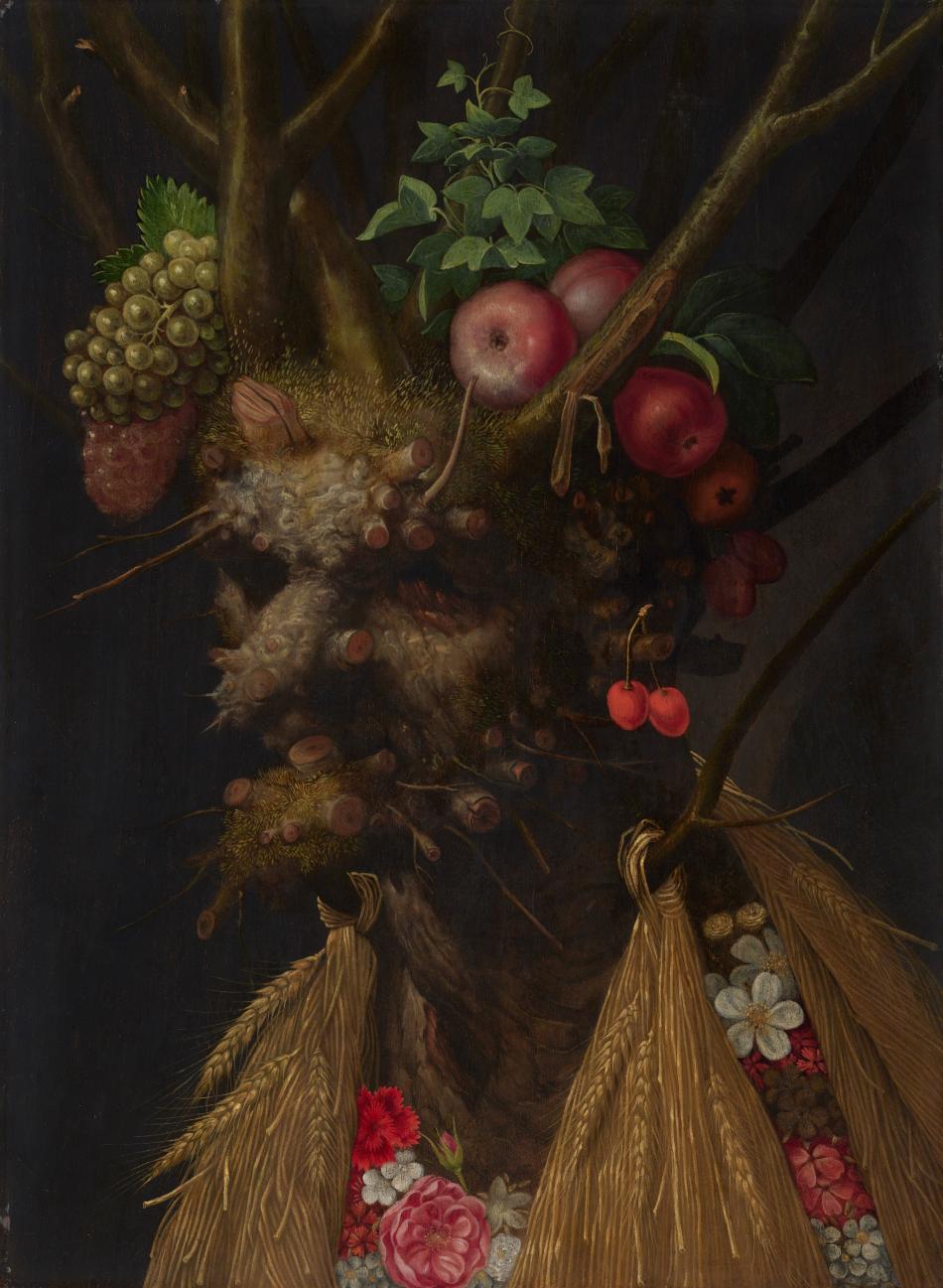Four Seasons in One Head
c. 1590
Giuseppe Arcimboldo
Painter, Italian, 1526 - 1593

From his own time as court painter in Vienna and Prague, the late Renaissance master Giuseppe Arcimboldo has been noted for his bizarre composite heads. Painted singly or in series, the heads combine plants, animals, and other objects appropriate to the themes Arcimboldo treated, such as the Four Seasons and the Four Elements (earth, air, fire, and water). The artist's Four Seasons in One Head, newly acquired by the Gallery, was publicly presented for the first time in the Arcimboldo retrospective held in Paris and Vienna in 2007. The exceptional importance of the picture was established in Sylvia Ferino-Pagden's exhibition catalogue entry, and its status as a late autograph masterpiece by the artist was recently confirmed by Thomas DaCosta Kaufmann in his 2009 monograph. Kaufmann hails the painting as "one of the most startling discoveries of works by Arcimboldo in recent years."
The panel is signed "ARCIMBOLDUS F," where the bark has peeled away on the branch at the right. It is also the subject of a lengthy description in a literary dialogue titled Il Figino written by Arcimboldo's friend Gregorio Comanini and published in 1591. Here the Milanese artist Ambrogio Figino is advised to have "Comanini show you Arcimboldo's playful treatment of the Four Seasons; you will see a lovely work." After accurately describing the painting, Figino is assured that "the work will please you wonderfully."
The flowers and fruit (apples, plums, grapes, and cherries) in the Four Seasons compare with the same or similar nature motifs in Arcimboldo's other works. In particular, the gnarled and rather menacing tree trunk and branches find exact parallels in the versions of Winter in the Louvre and in the Kunsthistorisches Museum, Vienna. The Four Seasons has the additional interest of the more engaging three-quarter view, unlike the strict profile Arcimboldo adopted for the Seasons and the Elements. The Four Seasons stands out in other respects as well. By contrast to the whimsical character of much of Arcimboldo's work, the mood is darker and more somber. The Four Seasons is also the most closely related of all Arcimboldo's composite heads to the physiognomic studies of Leonardo da Vinci, Arcimboldo's predecessor in Milan. Painted around 1590, after Arcimboldo had returned to his native city, the Four Seasons is one of his last works. If not a self-portrait of the artist in the "winter" of his life, the painting is a summa of his career.
Artwork overview
-
Medium
oil on panel
-
Credit Line
-
Dimensions
overall: 60.4 × 44.7 cm (23 3/4 × 17 5/8 in.)
framed: 90.49 × 71.76 × 11.43 cm (35 5/8 × 28 1/4 × 4 1/2 in.) -
Accession Number
2010.77.1
More About this Artwork

Video: Arcimboldo: Nature and Fantasy
Narrated by Isabella Rossellini and produced by the National Gallery of Art, this film traces the career of Giuseppe Arcimboldo, an artist whose work thrilled and delighted the Habsburg courts of the later 16th century.
Artwork history & notes
Provenance
Created by the artist for his friend, the writer Gregorio Comanini, who describes it in 1591.[1] Giovanni Pietro Cortoni, Verona, in 1656.[2] rediscovered 2006 in the collection of Ms. Stott, England, in whose family it had been since the early 20th century; sold 2006 to a private collection, the Netherlands; sold 2010 through (Pandora Old Masters, New York) to NGA.
[1] Gregorio Comanini, Il Figino, overo del fine della Pittura, 1591, translated by Anne Doyle-Anderson and Giancarlo Maiorino in The Figino, or On the Purpose of Painting: Art Theory in the late Renaissance, University of Toronto, 2001; pp. 27-28 contains the passage referring to the Four Seasons in One Head.
[2] Recorded in the inventory after Cortoni’s death in 1656, Inventario delle piture del quondam Ecc. mo. Sig. Dott. Gio. Pietro Cortoni di Verona, Archivio Assolino, Biblioteca Communale, Jesi, Italy, described in the Getty Provenance Index of archival documents no. I-3433.
Associated Names
Exhibition History
2007
Arcimboldo, 1526-1593, Musée du Luxembourg, Paris; Kunsthistorisches Museum, Vienna, 2007-2008, fig. 5.
2008
Loan to display with permanent collection, The Metropolitan Museum of Art, New York, 2008-2010.
2010
Arcimboldo, 1526-1593: Nature and Fantasy, National Gallery of Art, Washington, D.C.; Palazzo Reale, Milan, 2010-2011, brochure no. 17, fig. 27.
2017
Giuseppe Arcimboldo, The National Museum of Western Art, Tokyo, 2017, no. 1.12
Bibliography
2009
Kaufman, Thomas Dacosta. Arcimboldo: Visual Jokes, Natural History, and Still-Life Painting. Chicago, 2009: 61.
2010
Vogel, Carol. "Inside Art: Arcimboldo Work Bought in Time for Exhibition." New York Times (September 17, 2010): C26, repro.
Hofmann, Werner. Phantasiestücke—Über das Phantastische in der Kunst. Munich, 2010: 93, 95, color fig. 48.
Ferino, Sylvia. "Veg Heads with a Message." The Art Newspaper no. 212 (April 2010): 57, color repro.
Gopnik, Blake. "National Gallery Adds 'Four Seasons' to Its Collection." The Washington Post (September 17, 2010): C8.
2011
Tucker, Abigail. "Feast for the Eyes: Renaissance Artist Giuseppe Arcimboldo Paid Tribute to the Hapsburg Dynasty with Surreal Likenesses." Smithsonian 41, no. 9 (January 2011): 46-47, 50, color repro.
Inscriptions
upper right, on branch with peeling bark: ARCIMBOLDUS F
Wikidata ID
Q20176820

